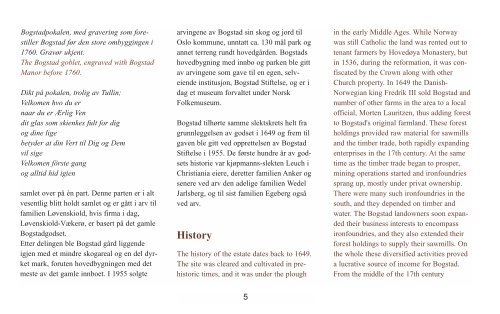Create successful ePaper yourself
Turn your PDF publications into a flip-book with our unique Google optimized e-Paper software.
<strong>Bogstad</strong>pokalen, med gravering som forestiller<strong>Bogstad</strong> før den store ombyggingen i1760. Gravør ukjent.The <strong>Bogstad</strong> goblet, engraved with <strong>Bogstad</strong>Manor before 1760.Dikt på pokalen, trolig av Tullin;Velkomen hvo du ernaar du er Ærlig Vendit glas som skienkes fult for digog dine ligebetyder at din Vert til Dig og Demvil sigeVelkomen förste gangog alltid hid igiensamlet over på én part. Denne parten er i altvesentlig blitt holdt samlet og er gått i arv tilfamilien Løvenskiold, hvis firma i dag,Løvenskiold-Vækerø, er basert på det gamle<strong>Bogstad</strong>godset.Etter delingen ble <strong>Bogstad</strong> gård liggendeigjen med et mindre skogareal og en del dyrketmark, foruten hovedbygningen med detmeste av det gamle innboet. I 1955 solgtearvingene av <strong>Bogstad</strong> sin skog og jord tilOslo kommune, unntatt ca. 130 mål park ogannet terreng rundt hovedgården. <strong>Bogstad</strong>shovedbygning med innbo og parken ble gittav arvingene som gave til en egen, selveiendeinstitusjon, <strong>Bogstad</strong> Stiftelse, og er idag et museum forvaltet under NorskFolkemuseum.<strong>Bogstad</strong> tilhørte samme slektskrets helt fragrunnleggelsen av godset i 1649 og frem tilgaven ble gitt ved opprettelsen av <strong>Bogstad</strong>Stiftelse i 1955. De første hundre år av godsetshistorie var kjøpmanns-slekten Leuch iChristiania eiere, deretter familien Anker ogsenere ved arv den adelige familien WedelJarlsberg, og til sist familien Egeberg ogsåved arv.HistoryThe history of the estate dates back to 1649.The site was cleared and cultivated in prehistorictimes, and it was under the ploughin the early Middle Ages. While Norwaywas still Catholic the land was rented out totenant farmers by Hovedøya Monastery, butin 1536, during the reformation, it was confiscatedby the Crown along with otherChurch property. In 1649 the Danish-Norwegian king Fredrik III sold <strong>Bogstad</strong> andnumber of other farms in the area to a localofficial, Morten Lauritzen, thus adding forestto <strong>Bogstad</strong>'s original farmland. These forestholdings provided raw material for sawmillsand the timber trade, both rapidly expandingenterprises in the 17th century. At the sametime as the timber trade began to prosper,mining operations started and ironfoundriessprang up, mostly under privat ownership.There were many such ironfoundries in thesouth, and they depended on timber andwater. The <strong>Bogstad</strong> landowners soon expandedtheir business interests to encompassironfoundries, and they also extended theirforest holdings to supply their sawmills. Onthe whole these diversified activities proveda lucrative source of income for <strong>Bogstad</strong>.From the middle of the 17th century5


